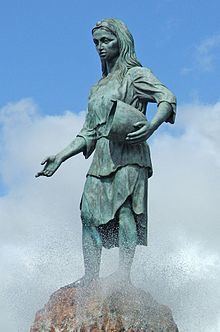Died UnknownUnknown | ||
 | ||
Occupation princess (daughter of Bencomo) | ||
D cil santana b same
Princess Dácil was a Guanche princess of the kingdom of Taoro on the island Tenerife (in the Canary Islands), best known for her marriage to a conqueror of the island.
Contents
- D cil santana b same
- Tryp tenerife princesa d cil tenerife uhd 4k
- Biography
- Personal life
- Influence on the Canary Islands
- References
Tryp tenerife princesa d cil tenerife uhd 4k
Biography
Dácil or Dácila was born in the ancient Menceyato (kingdom) of Taoro (Tenerife, Canary Island), during the early second half of the fifteenth century. She was daughter to Mencey (king) Adjona and Caseloria and granddaughter of Bencomo. She had five brothers: Bentor, Ruiman, Rosalva, Chachiñama, and Tiñate. Dácil was admired throughout the island for her beauty. Her future was mapped out for her to marry Duriman el Montañes (Duriman of the Mountains). However, with the arrival of the Spanish Captain Fernando García del Castillo, a Castilian officer of a Spanish Cavalry unit, Dácil gained another suitor. Captain Fernando García del Castillo was taken prisoner and placed under the care of Princess Dácil so that she could see to his wounds suffered in Battle of Aguere. According to several historians, Captain Fernando García del Castillo acted as a diplomat providing services between the Guanches and invading Spanish people, and was honored with some estimates by the King of Taoro.
Rumors began to surface that Captain Fernando García del Castillo and Princess Dácil were lovers. They were knowingly believed to have talked alone, a practice strictly forbidden by Guanche law. The Guanche, Duriman El Montanez, who was promised Dácil in marriage felt spurned, and further fed accusations her of being alone with a man, who, was, in addition, a Castilian, and, therefore, the enemy of the Guanche homeland. Duriman el Montañes asked Bencomo to arrest Princess Dácil (Bencomo's granddaughter). Bencomo complied with the law and imprisoned Dácil for many months. When she was released, Dácil was able to convince Bencomo that she had never met Captain Fernando García del Castillo alone, in fact, she had many witnesses to attest that she was always accompanied when meeting with the Castillian captain. She later married the captain in the Iglesia de la Concepción (Church of the Conception) of Los Realejos. She was baptized as Mencías del Castillo. The date of Dácil's death or place of burial are not known.
Personal life
She was described as blonde, freckles and green eyes (Like many other aborigines of northern Tenerife).
